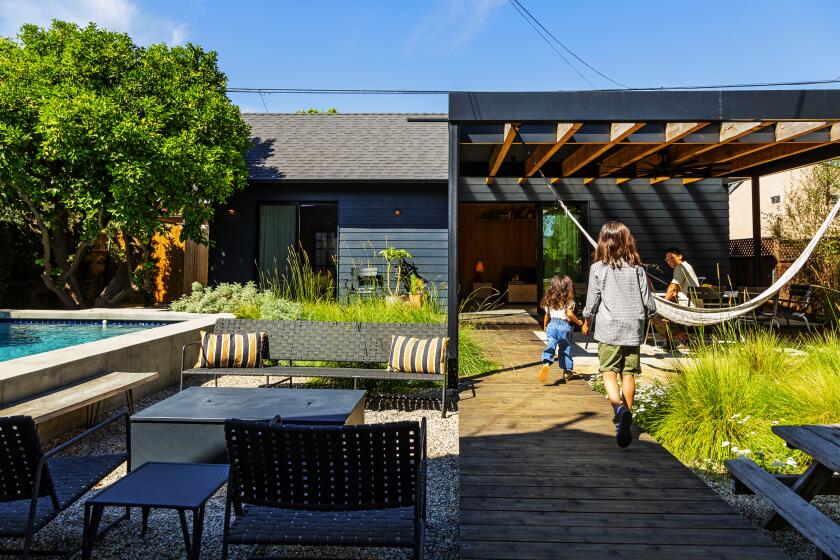Santa Ana Renovation Plan Helps Residents of Grand Central Building Get Better Housing : Forced Out but Moving Up
- Share via
SANTA ANA — When it rained, a 2-foot-wide hole in the ceiling of Jose Luis Magana’s modest studio apartment allowed water to pour in, soaking his kitchen. The sink in the same room backed up into the bathtub, which resulted in a deposit of brackish liquid so noxious that Magana, his wife and two sons were forced to use a neighbor’s bathroom.
But Magana and more than 25 other families living in the Grand Central Building received a lucky break, thanks to city plans to move them out.
The city, which plans to renovate and convert the building on North Broadway into living and working space for art students as part of its Artists Village redevelopment project, is helping to move Magana and nearly 150 other people into decidedly better housing.
Magana, a 25-year-old unemployed factory worker, will receive a $750 moving fee and $104 a month from the city for the next 42 months. The money allowed Magana to move his family out of their $400-a-month home in the Grand Central Building last weekend and into a more spacious, two-bedroom apartment about a mile away, where the rent is $700 a month.
“Yes it’s better, of course,” said Magana, as he sat in his old apartment last week, which was piled high with garbage bags full of clothes. “Here, we don’t even have a bedroom.”
While many residents said they still are ironing out final details of their relocation subsidies with the city, all expect to move into better locations. One resident even saw moving out as his civic duty.
“I don’t complain, because the city wants a cultural village,” said Marcelo M. Andrade, 54, who lives alone in a studio apartment. “If this is to do something for the community, yeah, I understand.
“I like this location, but I don’t like this apartment,” he said, pointing out cracked and peeling walls. “The bathroom and the kitchen are terrible.”
Residents and ground-floor business owners say that, in addition to obvious physical deficiencies such as damaged ceilings, the Grand Central Building is rat-infested.
The previous owner, Orange businessman Harry Greenberg, said he made an honest effort to keep the building in good repair.
“I took care of the place as well as I could,” he said, “and I did it right.”
Greenberg said he never received complaints about rats and never saw them himself. County Vector Control District officials said the only complaint about rats came in December of last year--after the city had taken ownership--from a city official who had been alerted by residents. City officials say there are no building code violations dating to 1993 when Greenberg purchased the building. He sold it to the city late last year.
The avowed purpose of redevelopment projects is to remove blight, and from time to time, relocated residents such as Magana receive better housing, city and federal officials say. But in Santa Ana, the Grand Central renovation also is forcing the city to grapple with the long-standing issue of overcrowded housing.
Because the city is using federal Community Development Block Grant funds for the renovation and relocation of Grand Central residents, it must comply with federal guidelines that deem most of the apartments overcrowded.
The city originally estimated relocation costs at $160,000, but the extent of the overcrowding became apparent only when the city took ownership of the building in September. Now, the estimated budget to relocate the residents and subsidize their rents at larger and cleaner apartments has jumped to $300,000. At their most basic, federal guidelines call for people to be relocated to “decent, safe and sanitary housing.”
For years, Santa Ana has unsuccessfully tried passing local ordinances and lobbying state lawmakers to reduce the number of people allowed to live in an average one-bedroom apartment to five. State law currently allows as many as 10 people in a one-bedroom, 600-square-foot apartment.
Bob Hoffman, the city’s redevelopment and real estate manager, said the city is committed to alleviating overcrowding with or without federal mandates.
“Even when we’re just spending city money, we’re not going to perpetuate an overcrowded situation,” Hoffman said. “We see that as more of an opportunity than a problem.”
Many of the Grand Central tenants appear to live in cramped conditions. City relocation coordinator Del Richardson said the most severe case was seven people in a one-bedroom apartment.
Officials say the increased relocation costs should not make a large dent in the $4-million Grand Central renovation project, but some are already critical of the entire Artists Village project.
“The city should be putting its focus on crime and youth,” Councilman Ted R. Moreno said. “That’s what we have in this town: youth.”
The Artists Village, which would be Orange County’s first publicly subsidized artists colony, enjoys strong support from five of the seven council members. It already has weathered an attack from critics, led by Moreno, who questioned the “morality” of at least one art exhibit.
But a majority of council members see the village--which will provide a place for artists to live, work and sell their wares--as a way to revitalize the downtown.
Plans call for the Grand Central Building, a centerpiece of the village, to be run by Cal State Fullerton and house 45 college art students and instructors. The university also will operate a restaurant and art gallery. A handful of privately owned art galleries surrounding the historic Grand Central, some already open, will round out the village.
Three businesses now on the first floor of the two-story Grand Central Building will receive money to relocate, or a onetime fee if they decide to close, Richardson said.
More to Read
Sign up for Essential California
The most important California stories and recommendations in your inbox every morning.
You may occasionally receive promotional content from the Los Angeles Times.






